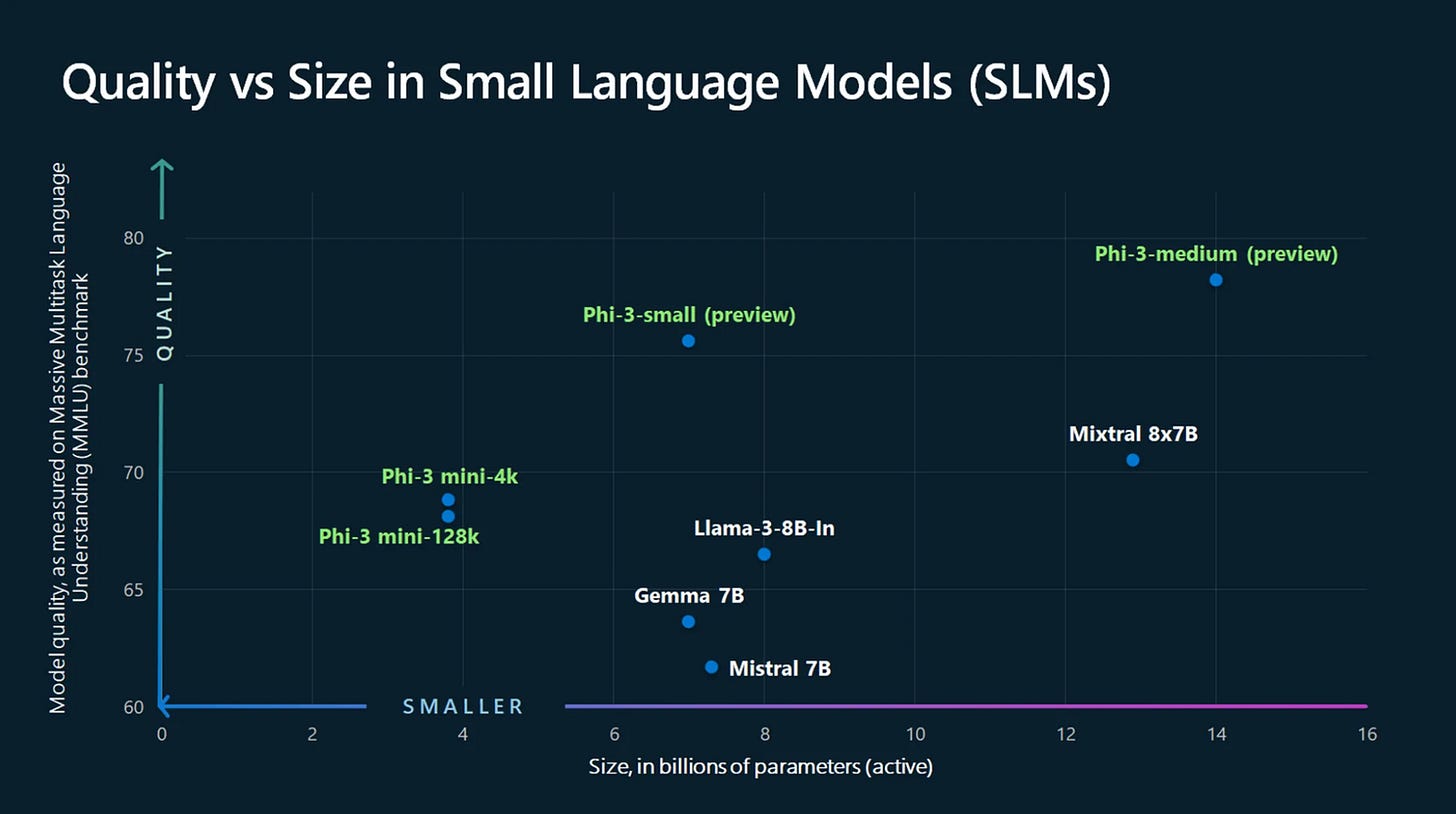Less is More: The Future of Small Language Models
Discover how Small Language Models (SLMs) are transforming AI with efficiency, affordability, and innovation. Explore the future of SLMs.
LLMs have been the focus of development in recent years, but recently there is a new kid on the block—small language models. Today, we will dive into what SLMs are, their pros, cons, applications, and the future of this incredible AI development.
What are Small Language Models?
Small Language Models are streamlined versions of their larger counterparts, designed to pack a punch without the heavyweight computational requirements. Think of them as the nimble, specialized athletes of the AI world, compared to the all-around powerhouses of Large Language Models (LLMs).
Key characteristics of SLMs include:
Smaller parameter count (typically ranging from millions to a few billion)
Faster deployment and lower latency
Lower computational resource requirements
Specialization in specific tasks or domains
For instance, Microsoft's Phi-3-mini model boasts just 3.8 billion parameters, a fraction of the size of many LLMs, yet it excels in tasks like language understanding, coding, and mathematics.
Benefits of Small Language Models
The advantages of SLMs are numerous and compelling:
Speed and Efficiency: SLMs offer faster deployment and lower latency – crucial for real-time applications.
Cost-Effectiveness: With lower computational demands, SLMs are easier on both the budget and the environment.
Targeted Excellence: These models often outshine larger ones in specific tasks, delivering precise and relevant outputs.
Enhanced Security: SLMs can be deployed on-premises, offering better control over sensitive data – a big plus for privacy-conscious industries.
Adaptability: Easier to update and fine-tune, SLMs can quickly evolve with changing needs.
On-Device AI: Their compact size enables AI capabilities on devices with limited processing power, from smartphones to IoT gadgets.
This efficiency and specialization make SLMs particularly attractive for businesses looking to implement AI solutions without the need for extensive computational resources.
Applications of Small Language Models
SLMs are finding their way into a variety of applications across different industries:
Customer Service: Powering chatbots and virtual assistants for efficient, natural conversations
Content Creation: Generating high-quality, relevant content for diverse needs
Financial Analysis: Processing data to identify key market trends and assist in decision-making
Healthcare: Assisting in patient triage, medical record analysis, and early-stage diagnosis support
Software Development: Supporting programmers with code completion and bug detection
Language Translation: Breaking down language barriers in real-time
Sentiment Analysis: Gauging public opinion and customer feedback
Limitations and Challenges
While SLMs offer numerous benefits, it's important to acknowledge their limitations:
Reduced Complexity: They may struggle with tasks requiring extensive reasoning or broad knowledge.
Limited Language Processing: Compared to LLMs, their language processing capabilities might be less sophisticated.
Niche Focus: Often trained for specific domains, SLMs may have limited ability to generalize across diverse applications.
Data Dependency: Their performance heavily relies on the quality and relevance of their training data.
10 Most Popular Small Language Models
Real-World Implementations
Google has been at the forefront of implementing SLMs, particularly in the realm of on-device speech recognition. The tech giant has developed and deployed tiny models that significantly improve the accuracy of voice recognition on smartphones and other mobile devices. These models operate locally on the device, ensuring faster response times and enhanced privacy for users. By leveraging SLMs, Google has managed to make voice-activated features more reliable and responsive, even in offline scenarios. This implementation not only demonstrates the efficiency of SLMs but also highlights their potential in improving user interactions with technology in everyday situations.
The Future of Small Language Models
As we peer into the future of Small Language Models (SLMs), several key themes emerge, each painting a picture of how these compact yet powerful AI tools will shape our technological landscape. Let's explore these themes in detail.
Industry-Specific Advancements
The coming years will likely see SLMs tailored for specific industries, revolutionizing sectors from healthcare to finance. In healthcare, we can expect SLMs to play a crucial role in personalized medicine, assisting doctors with rapid diagnosis and treatment recommendations based on individual patient data. The finance sector will likely leverage SLMs for more sophisticated fraud detection and real-time market analysis, enabling quicker and more informed decision-making. Education stands to benefit from personalized learning assistants powered by SLMs, adapting to individual student needs and learning styles. In manufacturing, these models could optimize supply chains and enhance predictive maintenance, significantly boosting efficiency and reducing downtime.
On-Device AI and IoT Integration
The compact nature of SLMs makes them ideal candidates for on-device applications, a trend that's set to accelerate. We'll likely see smarter IoT devices, from household appliances to industrial sensors, creating more intelligent and responsive ecosystems. Smartphones could offer more sophisticated language understanding and generation capabilities without relying on cloud processing, enhancing user experience while preserving privacy. This shift towards on-device processing addresses growing privacy concerns, as sensitive data no longer needs to leave the user's device for AI-powered operations.
Specialization and Customization
As SLMs evolve, we're likely to see increased specialization and easier customization. Expect the emergence of highly specialized SLMs tailored for specific tasks or industries, outperforming general models in their niches. Tools and platforms allowing businesses to easily fine-tune SLMs to their specific needs will likely proliferate, democratizing access to custom AI solutions. We may also see the rise of hybrid systems that combine multiple specialized SLMs, each handling different aspects of complex tasks, creating more versatile and powerful AI solutions.
Technological Synergies
SLMs are set to play a crucial role in the broader tech ecosystem, synergizing with other emerging technologies. The combination of 5G networks and edge computing will create new possibilities for real-time AI applications powered by SLMs, enabling faster and more responsive AI services. In the realm of augmented reality, SLMs could enable more natural and context-aware interactions, enhancing immersive experiences. Autonomous systems, from self-driving cars to robotic assistants, may rely on SLMs as their 'brains', enabling them to understand and respond to complex environments more effectively.
Ethical Considerations and Transparency
As SLMs become more prevalent in critical applications, there will be an increased focus on ethics and transparency. Efforts to make SLMs more interpretable will intensify, especially in regulated industries where decision-making processes need to be clear and accountable. We can expect to see more robust techniques for identifying and mitigating biases in SLMs, ensuring fairer and more equitable AI systems. Industry-wide standards for the ethical development and deployment of SLMs may emerge, guiding responsible AI practices.
Democratization and Environmental Impact
The efficiency and accessibility of SLMs have the potential to democratize AI technology. We're likely to see more high-quality, open-source SLMs become available, fostering innovation and accessibility. Low-code/no-code platforms may emerge, allowing non-experts to deploy and utilize SLMs for various applications. Online communities focused on developing and improving SLMs could drive rapid advancements in the field. Moreover, the efficiency of SLMs aligns well with growing environmental concerns. As organizations shift to these more efficient models, we may see a notable reduction in the carbon footprint associated with AI processing, making SLMs a cornerstone of the "Green AI" movement.
Synergy with Large Language Models
Rather than completely replacing Large Language Models (LLMs), SLMs are likely to find a complementary role. We might see complex AI systems using LLMs for broad knowledge tasks and SLMs for specific, real-time operations. Techniques for distilling knowledge from LLMs into more efficient SLMs are likely to advance, creating powerful yet compact models. Hybrid cloud-edge solutions may emerge, where LLMs in the cloud work in tandem with SLMs on edge devices, offering the best of both worlds in terms of capability and efficiency.
Closing Thoughts
Small Language Models represent a significant leap forward in the world of AI. Their blend of efficiency, specificity, and accessibility makes them a powerful tool for businesses and developers alike. As we look to the future, it's clear that SLMs will play an increasingly important role in shaping how we interact with and benefit from AI technology.





